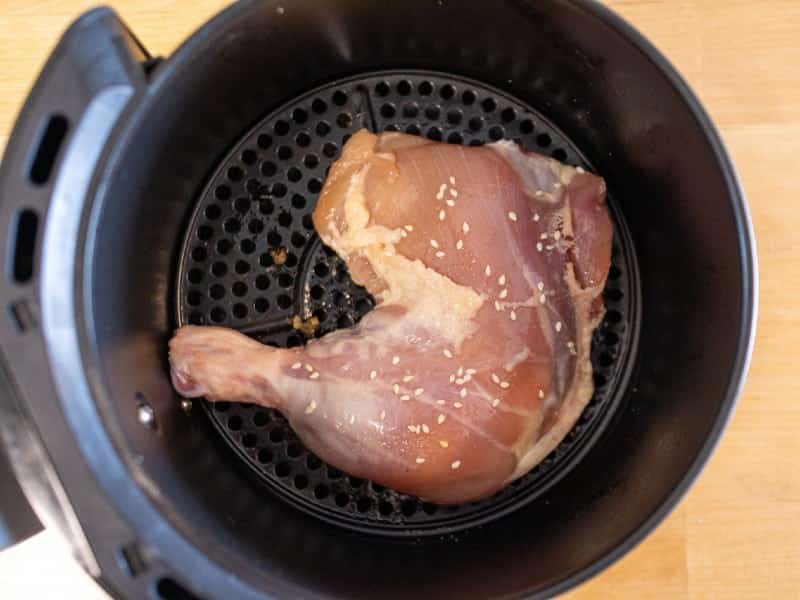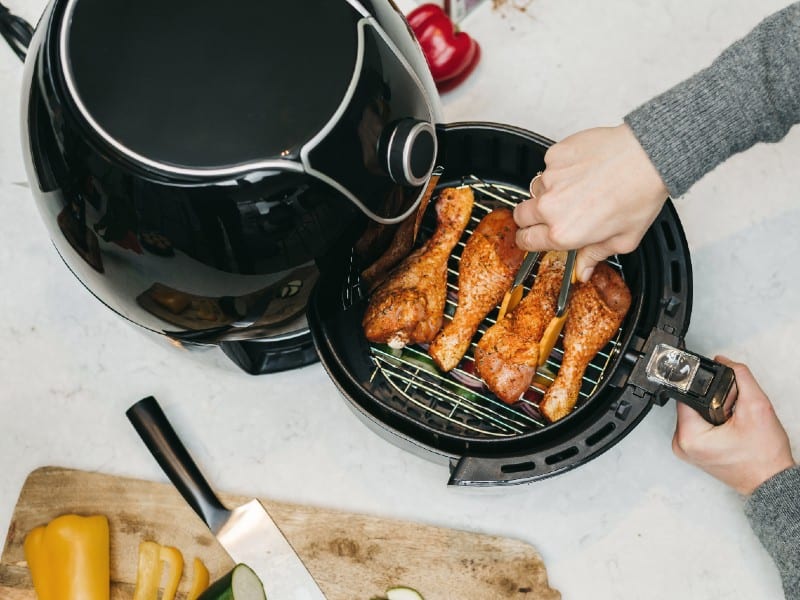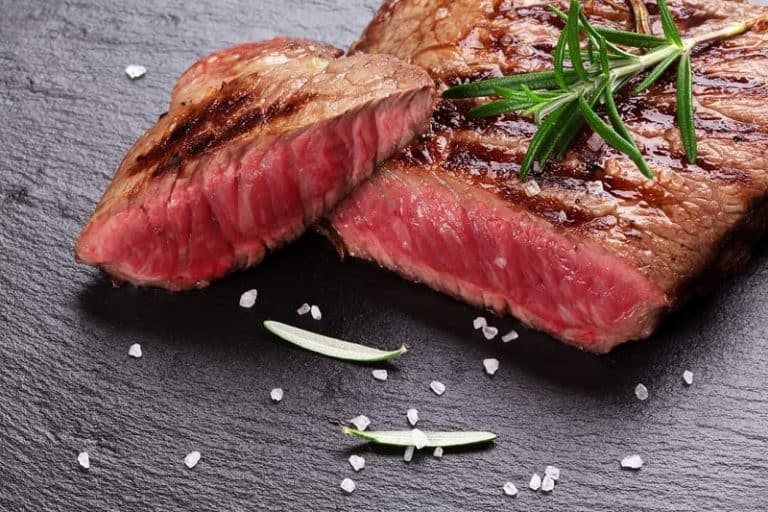Can You Use an Air Fryer for Food Dehydration?
Air fryers, appliances that use a minimum amount of oil to fry food, are becoming must-have additions to every kitchen. Their popularity is mainly down to the fact that they are a much healthier option than traditional methods of frying. And we all know how much more we are looking after ourselves and paying attention to the healthier options nowadays.
Instead of immersing the food in oil, an air fryer cooks the food using hot air convection with just a small amount of oil which creates a mist to coat the food and fry it without the food sitting in oil and absorbing large amounts.
They typically use 70-90% less oil than the traditional method of immersing the food in oil, in either a shallow pan or deep fat fryer. French fries absorb around 25% of their weight in oil if deep-fried! This also means that when you cook snacks like frozen burritos in an air fryer, they’ll end up crispy, and when you reheat foods like pizza in an air fryer, they don’t get soggy.
I used to see how quickly the level of oil in the bottle next to the hob would go down but there’s definitely a lot less oil going into my food now. The only unhappy person now is my olive oil supplier.
Air fryers are also very efficient; using less power than a conventional oven, and more compact compared to a conventional oven giving a more concentrated cooking area.
On top of the obvious health benefits, there is an extra lesser-known benefit of these air fryers.
An air fryer is in fact a mini oven that circulates hot air around the food to cook it. That hot air convection can be put to other uses. And one of those is to use it at lower temperatures to dehydrate food rather than cook it.
So to answer the question, ‘Can you use an air fryer to dehydrate food?’, the answer is a definite ‘Yes’.
What Is Dehydrating Food? And Why?

Dehydrating food is drying food, mainly to preserve it, to last longer. For centuries man and woman have been dehydrating food to be able to store it for longer periods, to make it last through the winter months.
Before the existence of refrigerators and freezers, and canning of food and, dare I say it, artificial preservatives to add to food, dehydrating food was very common to stop food going bad. Particularly fruit, meat, and fish. The principle behind this is that bacteria, yuk, need moisture. So if you remove the water from the food, bacteria can’t grow. Voila, long-lasting food.
It’s not as easy as it sounds though because the moisture has to be removed slowly and not at too high a temperature. Too quickly and too hot is, well, just cooking it.
The most common way was to place it on racks and leave it in the sun, which, combined with a breeze would dry it out. Easy in sunny Mediterranean countries, not so easy further North. Fire was also used with food hung or placed nearby, but not too near as to cook it.
Another method of preserving food was salting it, coating it with lots of salt. This was used mainly on meat and fish.
Salt also has the effect of drying the food as the salt pulls the water out of the food. The salt itself has the extra benefit of killing microbes. Well done salt. At least on meat and fish, not so nice on fruit! Salted strawberries anyone? So I think we’ll stick with dehydrating when it comes to fruit.
Over time we developed other methods of preserving food like the aforementioned fridges and freezers and dehydrating became less and less the go-to way of preserving food.
So Why Are We Still Dehydrating Food?
Not only that, dehydrating concentrates the flavors of the food. It condenses all the flavor down, literally the opposite of watering it down. Healthy AND tasty? What’s not to like?
So now it’s more of a lifestyle choice than a necessity.
Before it was to survive a winter with no crops growing to feed ourselves. Now it’s about having some delicious and healthy dried apricots for your hike, or the kids’ school lunch boxes. Or dried bananas and blueberries with your breakfast in the morning. Yummy and healthy. And so much better homemade. Or should I say, home-dried?
And how about home-dried mushrooms and onions to use in a scrumptious homemade soup?
And one use we probably don’t even think about. Herbs. All those jars in the kitchen of basil and oregano and all their friends aren’t just herbs. They’re dried herbs. They last for weeks and we use them all the time.
Well most of them, maybe not so much the distant cousins at the back of the cupboard.
And not forgetting its original purpose, preservation. The beauty of dehydrating food, yourself, in your own air fryer at home is that it makes your food last longer, so you can make exactly the quantities you use, and store them for use later.
You always have exactly what you fancy at hand with no wastage, saving money. We all love that.
If you grow your own fruit or vegetables then dehydrating your spare crop is a great way to make the maximum use of your homegrown food and minimizing wastage. And save even more money.
It gets better and better. Healthy and tasty and money-saving.
And Why Use An Air Fryer?

There are 3 key things to look out for to get the best dehydration results.
- Having a circulation of air to distribute heat evenly and carry away moisture. This is exactly what an air fryer is designed to do already.
- Getting the temperature right – around 40-50°C or 105-125°F, so it dehydrates and doesn’t cook. Most air fryers should be capable of that.
- Time. It will need to be on a lot longer than for cooking as dehydration is a slow gradual process. Don’t rush it, it needs time for the moisture to come out. Think in hours, not minutes.
An air fryer that can do all of the above will be a great dehydrator, it also gives you so much more.
Yes, there are dedicated food dehydrators out there but why get something that only does one thing when you can get something that will do the same thing, plus way more. You can get an appliance that also cooks healthy fried food, and probably for less money too.
Is there any other single appliance that can create great french fries, fried chicken, onion rings, prawns, salmon, beef steak, bacon, donuts, baked and roast potatoes as well as dried apricots, apple, cherries, pineapples, and bananas?
And don’t forget the dried mushrooms, onions, and tomatoes for soups and stews.
And instead of watching those live herb plants wither and waste away on the window sill, turn them into your own dried herbs that last for weeks. All from one appliance that is small enough to sit on the countertop.
And dehydrating food yourself at home only adds to the health benefits as you can do it without the additives used on some products in shops, especially sulfur in dried fruits that can cause a lot of allergies. It’s also very common for oil to be added to give fruits like raisins a shine too.
I think we can cope with raisins that aren’t shiny, especially if it benefits our health. And you can dehydrate products you can’t even get in stores.
There are a variety of air fryers for all budgets, some even have a dedicated setting for dehydrating but most will be able to dehydrate even without a dehydrate button.
To make life even easier and get better results you can get special dehydration racks. Not huge ones shaped from branches and stones that our ancestors used! Small metal ones designed especially for air fryers.
Part of the success of dehydrating food in an air fryer is getting air circulating around the food as much as possible to pull away from the moisture. They’re built to do that already to evenly cook fried food so it’s perfect for dehydration too.
The special racks take it to the next level – of dehydration, as well as height. They are designed to include space to allow the air to flow around the food. So in essence we’re saying that dehydration needs space and time. Sound familiar?
And don’t forget the safety aspect too. Air fryers are stable, enclosed, and with little or no hot oil in them. Compare that to a deep fat fryer full of a liter or more of fat, or an open pan of hot oil sitting on a hob, with a long handle sticking out asking to be knocked by a stray arm. Ouch!
Another worthy read: How to Cook Frozen Mozzarella Sticks in an Air Fryer
What Can I Dehydrate In An Air Fryer?

I’ve already mentioned quite a few foods you can dehydrate. The list is almost endless. Use your imagination and experiment. The most popular ones are:
- Fruit – The most common food that you’ll want to dehydrate. Pretty much any fruit but try the more common pineapples, bananas, apricots, apples, raisins, sultanas, currants. (Fun fact – raisins, sultanas, and currants all come from grapes. That’s where the fun stops and the confusion begins around which is which). How about trying melons, figs, dates.
- Vegetables – Onions, mushrooms, tomatoes (how great to have your own sun-dried tomatoes), potato and sweet potato crisps, (either dehydrated or air fried). Vegetables can be partially cooked before dehydrating depending on what you are going to use them for. You can even turn your dried veggies into powder for use in sauces and stews.
- Meat – Cook the meat first. Cut into strips or cubes using a jerky slicer. Make your own biltong, beef, or turkey jerky. Makes great treats for dogs.
- Herbs – Don’t forget about the herbs, again.
Tips For Best Results
Choose your air fryer carefully.
- Check that the product is capable of dehydration; it can maintain lower temperatures, circulate air, and vent moisture.
- Choose the right size. Make sure it is big enough to take the foods you want to dehydrate, taking into account allowing for the essential space between pieces.
- If you’re buying a dehydrating rack at the same time, make sure they are compatible with each other.
- It has to look great! Matching the color scheme if you can. Come on, we’re not neanderthals.
Make sure there’s no oil in the air fryer if you’re dehydrating food! Oil is for cooking.
Allow time. We’re talking hours here, even days. So don’t think of drying some apricots for the kids when the school bus is coming round the corner. Unless you want them for next week. They can be stored for a long time so may as well do things in advance.
Find the recommended drying times and temperatures for each food. A little tweaking (not twerking!) and trial and error for best results will reap tasty rewards.
Preparation:
- Cut into slices, thin is important to make sure it dehydrates all the way through.
- Cut into equal-sized pieces so they can all dry at the same rate.
- Make sure no excess water on the pieces. May as well give it a head start. Watermelons may not be so easy.
Don’t forget to turn the pieces while drying to make sure they dry all over.
Storage – Make sure whatever food you have dried is stored properly. Ziplock bags are great for most things, especially with excess air squeezed out. The beauty is they don’t need to be refrigerated or frozen.
Another read: How To Find The Best Stock Pot For All Your Favorite Soups And More
In Summary
You can use an air fryer to dehydrate food. It’s a relatively low investment that will open you up to a whole new world of healthy, nutritious, and super tasty foods that last for weeks, months, and even years while reducing waste and saving money. You’ll be so moved, there won’t be a dry eye in the house.





